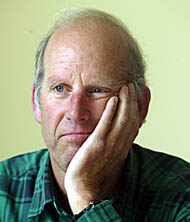La Grande Bouffe
By Dick Williamson
 In the newspaper Le Courrier de Paris we read this striking sentence:
In the newspaper Le Courrier de Paris we read this striking sentence:
“A very good dinner is a rare thing today. Gastronomy is like poetry: It is in total decline.” Now, that pronouncement was made on March 27, 1858, but many contemporary gourmands would agree. From my experience in Mûr-de-Bretagne on a July evening in 1976 I must disagree completely.
As the director of a program of study abroad in Saint-Brieuc during six weeks of that summer, I wanted to reward my staff with a good dinner. The woman in charge of finding French host families for my students mentioned a new restaurant in Mûr-de-Bretagne that wanted to establish a reputation for gourmet cuisine and would welcome 12 people on a weekday evening. “Pas de problème,” I was told, and we drove the 40 kilometers to Chez David to enjoy one of the most amazing dinners I have seen.
We began with fruits de mer, an assortment of raw seafood: clams, mussels, large rock crabs, different sizes of shrimp, and bigorneaux, or small periwinkles. These tiny snail-like delights are difficult to eat: One uses a large pin to dig around in the shell and spear the small tidbit of meat, which can be dipped in garlic mayonnaise or enjoyed plain. I am unsure how many one would need to eat to feel full, maybe a couple hundred. The fruits de mer platter was a wonder to behold: Ice was stacked on a tray and the shellfish climbed the ice, with the crabs on top.
Next to be delivered to the table: sea bass in a heavy cream sauce, more likely a heavy butter sauce, because it was incredibly rich.
When we arrived at the table, we noticed the stack of plates in front of each chair and the array of forks, knives and spoons. We now realized that the nine plates represented, each one, a course of the meal. We were eating fish on No. 2.
No. 3: the first of two meat dishes. A pork chop stuffed with apples and pears, and surrounded by four or five green beans and three slices of potato.
The meat course following was a tournedo with a heavy carmelized sauce, made with cognac (I could taste it with no problem). Accompanying the tournedo were four or five slices of squash and a purée de pomme de terre, thin mashed potato.
We had begun this bouffe around 8h30 and I noted that it was 10h15, as we waited for plate No. 4 to be cleared and plate No. 5 to appear. My companions and I were beginning to worry about stomach overload and someone suggested that we take a short walk. I asked the waiters if that would be possible, and one replied, “Pas de problème,” but make sure to return in 15 minutes. Twelve people bumped down the main street of the small village of Mûr-de-Bretagne, but there was still some light and we did become lost.
Plate five: salad. Whew! Plate six: a cheese cart was rolled up to the table and each person could select as much or as little cheese as one wanted. I asked for a small slice of brie, a small crottin, or goat cheese round, and a small slice of morbier, a cheese with a line of blue in the middle of the gold.
Plate seven: a crème caramel. I had to pass; I could not handle it.
Plate eight: a goblet with three small scoops of sherbet, raspberry, mango and lemon.
Plate nine, the final: two rectangular bricks of pure chocolate, fairly thin. I succeeded in nibbling on one and placed the second into a piece of paper to save for the next day.
Now, during this bouffe, we enjoyed four different kinds of wine, with three bottles of each placed on the table. Each wine complemented marvelously that particular course, but the quantity soon began to take its toll.
We arose from the table the second time at 12h25a.m. I decided that I needed to walk again before driving back to Saint-Brieuc, as did my colleagues, so we marched up and down the main street for a half-hour.
As the French would repeat: “Quelle bouffe!” The food was, indeed, superb, and the total experience gratifying and exciting.
Hélas, the restaurant closed a year later.
This article by Richard Williamson, Charles A. Dana Professor Emeritus of French, first appearedin the online Bates publication E-clectic. Williamson died in June 2007.